STWM Race Report
STWM race report … The Gordon Lightfoot Edition.
Ok, so bla, bla, bla, and yada yada, yada, … and then the STWM was over… so what was the big deal ? Well, aside from this being my 27th marathon, and according to an un-named friend…(let’s just call her EJ for short) I set a PB of 4:36:42 as was so aptly pointed out to me by her that technically, this was the fastest I have run this distance in my new age category…so technically, … it’s a PB…technically…
All in all I had a great race…but I have to say that after about marathon number 16 this distance kind of starts be a bit “old comfortable shoe” kind of boring.
Don’t get me wrong, STWM organized a great race, the course was awesome. I liked the changes to the course… up to Bloor Street and across to Bathurst Street then South to the Lakeshore…as well as the extended run through The Beaches. The volunteers were simply the best, and without them this race wouldn’t have been possible. Mother Nature was kind to us and the weather held. Fan support was incredible…except between the lonely stretch around 20km through to 23km…or maybe it was just me “being in the zone.”
You see, I had a lot on my mind in the days leading up to this race, so … if you dare… and if I may reference a line from the great Canadian singer / songwriter Gordon Lightfoot… “IF YOU COULD READ MY MIND, WHAT A TALE MY THOUGHTS COULD TELL”… please feel free to read on.
WARNING: THE FOLLOWING ARE EXCERPTS OF THE AUTHOR’S THOUGHTS LEADING UP TO, DURING AND AFTER THE STWM…READER DISCRETION IS STRONGLY ADVISED !!!
Wednesday:
…hmmm, weather doesn’t look too promising … are you kidding me, does that say 40km/hr winds and rain…ok, you’re prepared for this distance, you’re injury free, your new shoes feel good, this is no big deal…but I’ve just changed shoe brands, and have never run this far in these…RELAX…last taper run…light 5k…shoes are fine…
Thursday:
…looked at the weather again… PANIC…now it’s saying 50km/hr winds and rain…I really hate running in rain and wind…whose idea was it to run this damn race…oh, mine…am I a moron or what…calm down…what to wear on race day…warm and dry…ya, with my luck maybe a snowsuit…hate you Mother Nature…
Friday:
…ok, the plan is to run the first 10k with my buddy Jay, I know he’s injured, but I am going to take him through this whole race if I have to…it’s his second race…boy he’s being smart about what might happen… good plan… my friend Kelly is running her first race on her birthday, nice…she will do just fine…got to pick up race kits…
Saturday:
…did I forget to get some gels for the race…hope the running store is open this late…great…I am out of Vector…and it’s Saturday night… I know this is a small town and all, but how can BOTH GROCERY STORES BE SOLD OUT OF VECTOR…PANIC 2.0…ok, stomach…it’s Mini Wheats or bust…chip on the shoe, bib on the shirt, right side up this time… bandages for the nipples, … one last weather check…ok…only 35 km/hr winds…but still going to rain…GARMIN IN CHARGE MODE / BODY GLIDE ON STAND BY …must send out emails to Paula, Catherine, Kelly and Jay… don’t forget to set the alarm and wake up to it this time…
Sunday Morning… Pre Race Ritual:
…alarm sounded…feed the cats…shower…hope Jay’s up… mustn’t forget to pick him up …did I gas up the car…dare I check the weather…uh oh…still 30km winds and rain…gonna be a wet race…happy wet birthday race Kelly…breakfast and a small coffee…damn…how is it that there’s no Vector in this town…don’t they know it’s race day …eat the Mini Wheats…shower…check weather again… get rid of breakfast…ok… don’t skimp on the Body Glide this time…band aids on the nipples… get dressed…check the weather…PANIC 3.0…do I wear a long sleeve and no shell or a short sleeve and a shell or a short sleeve and a throw away shell…take it all and decide when you get to the city…pick up Jay…TIMMIES…but just a small one…
Waiting in the lobby of a hotel near the start line:
…lots of runners here…we should have stayed here …it’s so near to the start line… wonder how much it costs…where’s the washroom… awesome chat with the locals…wow, just met a 66 year-old man and his wife running 100th marathon and from SWEDEN; good on you and welcome to CANADA, at least it’s not snowing…hope I am still running years from now…lots of first timers too… still raining…
Start line…Corrals:
…hey, it stopped raining… wow… this just might blow over… why can’t I get a signal for my Garmin… oh, step into the middle of the street moron…you’re under a cement canopy… don’t start off too fast…stick with Jay…go at his pace… where’s the wind…thank you Mother Nature… now I know what it’s like to feel like cattle…wow, crowded in here…looking for good friends Paula and Catherine running the half, and Kelly running her first marathon on her birthday no less…hope they do well…you can’t find anyone in this orgy of runners… you know I can’t read my Garmin without my glasses…maybe I should look into that laser surgery thing…when is the start…oh…there it is… and we’re off…and we stop…and we walk…and we stop…oh…this is normal…I can’t even see the start line yet…no rain…no wind…wish everyone luck and a good race…did I use enough Body Glide…finally we’re running… took them long enough…

Start-10k
…ok legs feels good… all systems check… getting warm…no, getting really warm…wow this might be a great day for a race after all…keep the shell…lose the shell…keep the shell…damn… Jay looks ok… no pain so far…SLOW DOWN…it’s only the first 2km…check pace…toss the shell…grab a drink… course is nice but still no room to run…course support is good…hey is that guy using a thermal coffee mug as a cow bell…cool idea… how is it you gotta pee this early in the race buddy…frantically looking for port-o-let…look at the line up… frantically looking for private area to pee…wait for Jay, how much did you drink man…feeling better Mr. Drink Too Much… 6k marker…watch says we’ve done a bit more than 6k…volunteers are awesome…sign reads “ran like you stole something else”…hehe…legs good, Jay is good…all is good…hope Kelly is doing ok…speak of the devil…there she is… Happy Birthday small talk, introduce Jay…keep running… take back what I said earlier about hate and Mother Nature…
10k-20k
… running strong, no wind, no rain, no pain….wow these shoes are really awesome… great…now I have to pee… looking…looking… looking…still looking… found a spot … go ahead buddy, I’ll catch up…honest…running again…feeling really good… was that the 14k marker…wow, band sounds good… lots of fun… what are you doing trying to cross the course, runners only please … pet peeve number one… splitting from the half marathon runners…miss you guys, see you later… good luck, you can do it…ya, lucky for them their race ends in about 10 min…my race is just starting…camera guy… smile… wonder how many of them I have missed… I am so lonely … good luck half marathoners… good friends Paula and Catherine are on their way to an awesome half-marathon finish, you go girls…
20k-35k
…where’s Jay, where’s Kelly, see them both on the out and backs… encourage them both… see lots of amazing runners…running great … no pain… weather is good… crowds are good…is that the sun, wow…I just PB’s my 30k…photo op ahead…run right at him and SMILE…back to the zone…Beaches already… there’s Jay, running strong, injury my ass, he’s just behind the 4:25:00 bunny…Kelly is about 8 min behind me… hey was that guy barefoot…you’re a better runner than I am…ouch… new best sign reads…”failures never start, quitters never win, winners never quit”…ah the wisdom of a race poster…

35k-42k
… sun is out now and I am really warm… almost too warm…glad I got rid of my shell …good call…just because they can read your name on your bib doesn’t mean you are going too slow…keep running…focus on form..this is a lousy 7k…I can run a 7k blindfolded…ok maybe not blindfolded…but It’s 7k…starting to notice fans and water stations and music and everything except me…system check… all OK… 2k to go…this one’s in the bag… hey Kelly where did you come from…wow…great pace… happy birthday for like the 6th time…good for you… there ‘s the finish, just keep running, just keep running, just keep running…100m left.. finish ahead…still feel great…don’t look at your watch when you cross the line…you have lots of pictures of you shutting off your watch…smile..ok, grit your teeth…it kinda looks like a smile… crowds are cheering, I hear music…no, I really hear “Music” by “Madonna” …ok..and I’m done…get the medal..where’s my medal…got my medal..thank the people handing out the medal… meet up with and congratulate Kelly…her first marathon on her birthday, awesome… where’s Jay…any food left… really hungry, but legs feel really good… awesome run self…think I have found a new best shoe… race nirvana…


Post Race:
…meet up with Jay, congratulate Jay, have to drive home… why did I buy a car with a standard transmission … man I smell…man you smell too Jay… open a window will ya…hey I am really getting the hang of changing gears without a clutch…”we don’t need no stinking clutch” hehe …speaking of stinking, will ya open a window please…ok self, you did really well today…enjoy the moment, now suck it up…GOOFY IS NEXT !!!
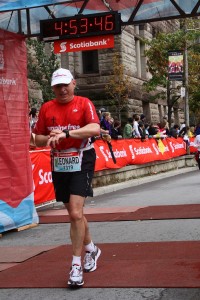




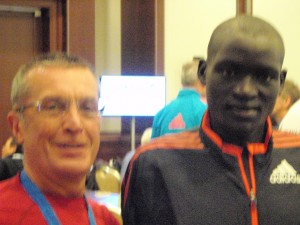
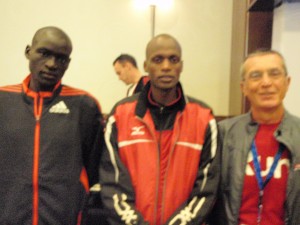 Hello runners: September 30 has come and gone, and I think my energy.
Hello runners: September 30 has come and gone, and I think my energy. VICKY: I agree. Running on the roads is a bore. Well, at least for me it is. I was out for our traditional Thanksgiving hike at the
VICKY: I agree. Running on the roads is a bore. Well, at least for me it is. I was out for our traditional Thanksgiving hike at the 

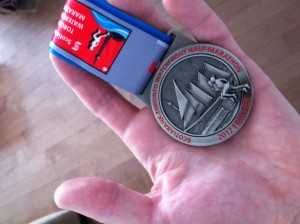


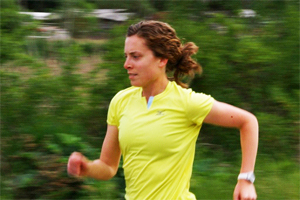 Nikki Reiter holds a master’s degree in biomechanics and is a Mizuno Running Brand Ambassador and the Women’s Cross Country Running Head Coach at the University of British Columbia Okanagan campus in Kelowna, BC. She is also the Laboratory Coordinator in the School of Health and Exercise Sciences at UBC Okanagan where she facilitates undergraduate laboratory learning.
Nikki Reiter holds a master’s degree in biomechanics and is a Mizuno Running Brand Ambassador and the Women’s Cross Country Running Head Coach at the University of British Columbia Okanagan campus in Kelowna, BC. She is also the Laboratory Coordinator in the School of Health and Exercise Sciences at UBC Okanagan where she facilitates undergraduate laboratory learning. Despite the name,
Despite the name,  Fast forward a few years, and Bustos is showing no signs of slowing down; he has represented Canada several times in international masters championship races. In 2005, for example, he won his age group in the half marathon and placed third in his age group in the 1500m at the World Masters Games in Edmonton.
Fast forward a few years, and Bustos is showing no signs of slowing down; he has represented Canada several times in international masters championship races. In 2005, for example, he won his age group in the half marathon and placed third in his age group in the 1500m at the World Masters Games in Edmonton.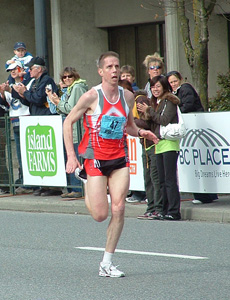 By: Mark Bomba
By: Mark Bomba Current Issue
Current Issue Previous Issue
Previous Issue Prior Release
Prior Release
